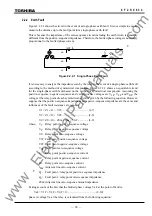
22
6
F
2
S
0
8
3
4
2.3.2.4 Possible Attenuation of Carrier Wave in Power Line Carrier
There are no particular problems related to power line carrier or multi-terminal lines. However,
when the distance of the line from a branch point is 1/4, 3/4, 5/4 and 7/4, etc. of the wavelength of
the carrier wave, the reflected wave from the branch line may cause considerable attenuation of the
carrier signal, and thus care is required in selecting the carrier frequency. Furthermore, when the
same carrier frequency is used for each terminal, the signal from each terminal may not be
received due to the beat phenomenon, and thus it is desirable to use the carrier wave for each
terminal with a different frequency in a multi-terminal system.
2.3.3 Three-Terminal Line Protection
2.3.3.1 Distance Relay Protection
The relay at terminal A in Figure 2.3.2.1 will underreach due to an infeed current from terminal B.
However, the zone 1 element of distance relay should not overreach for a fault on the busbar at the
remote end under any conditions. Therefore, the relay at terminal A is set so that it may operate
correctly for faults within the protected zone in the absence of a power source at terminal B. This
makes it unavoidable for the relay at terminal A to permit considerable underreach for an infeed
current from terminal B.
When there is a branch point on the line between terminal A and terminal B and it is connected
with terminal C via a short-distance line as shown in Figure 2.3.3.1, the setting range of the zone 1
element at terminal A and terminal B can only include part of the entire length of the line as shown
in the figure to avoid unwanted operations for external faults at terminal C. Therefore, for most of
the faults on this line, one end is delayed-tripped by the zone 2 element. To avoid such a problem
a directional comparison method or current differential method must be used.
Figure 2.3.3.1 Short-Distance Tapped Line (1)
2.3.3.2 Command Protection
Permissive Underreach Protection (PUP)
With the Permissive Underreach Protection (PUP) method, all the terminals are tripped via
transmission if zone 1 element operates at least at one terminal. In this system, a common power
line carrier is available.
In the system shown in Figure 2.3.3.2 where both terminal B and terminal C are near the branch
point and connected via a short-distance line, the distance relay at terminal B and terminal C must
unavoidably be set to an extremely short distance to prevent unwanted operations by busbar faults
at each other's end. In order for the relay at terminal A not to operate on a busbar fault at terminal
B or terminal C, it may not be able to set the branch point within the protection range, containing
a zone in which it is impossible to detect the fault as an internal fault. The fault in this zone is
removed by tripping of zone 2. When a current flows out of terminal B in the event of a fault inside
terminal C as shown in the example in Figure 2.3.2.2, the PUP system performs tripping of
terminal B sequentially following the tripping of terminal C.
Terminal B
Terminal A
Terminal C
www
. ElectricalPartManuals
. com
Summary of Contents for GRZ100-211B
Page 323: ... 322 6 F 2 S 0 8 3 4 w w w E l e c t r i c a l P a r t M a n u a l s c o m ...
Page 343: ... 342 6 F 2 S 0 8 3 4 w w w E l e c t r i c a l P a r t M a n u a l s c o m ...
Page 383: ... 382 6 F 2 S 0 8 3 4 w w w E l e c t r i c a l P a r t M a n u a l s c o m ...
Page 395: ... 394 6 F 2 S 0 8 3 4 w w w E l e c t r i c a l P a r t M a n u a l s c o m ...
Page 411: ... 410 6 F 2 S 0 8 3 4 w w w E l e c t r i c a l P a r t M a n u a l s c o m ...
Page 423: ... 422 6 F 2 S 0 8 3 4 w w w E l e c t r i c a l P a r t M a n u a l s c o m ...
Page 443: ... 442 6 F 2 S 0 8 3 4 w w w E l e c t r i c a l P a r t M a n u a l s c o m ...
Page 451: ... 450 6 F 2 S 0 8 3 4 w w w E l e c t r i c a l P a r t M a n u a l s c o m ...
Page 459: ... 458 6 F 2 S 0 8 3 4 w w w E l e c t r i c a l P a r t M a n u a l s c o m ...
Page 463: ...w w w E l e c t r i c a l P a r t M a n u a l s c o m ...










































